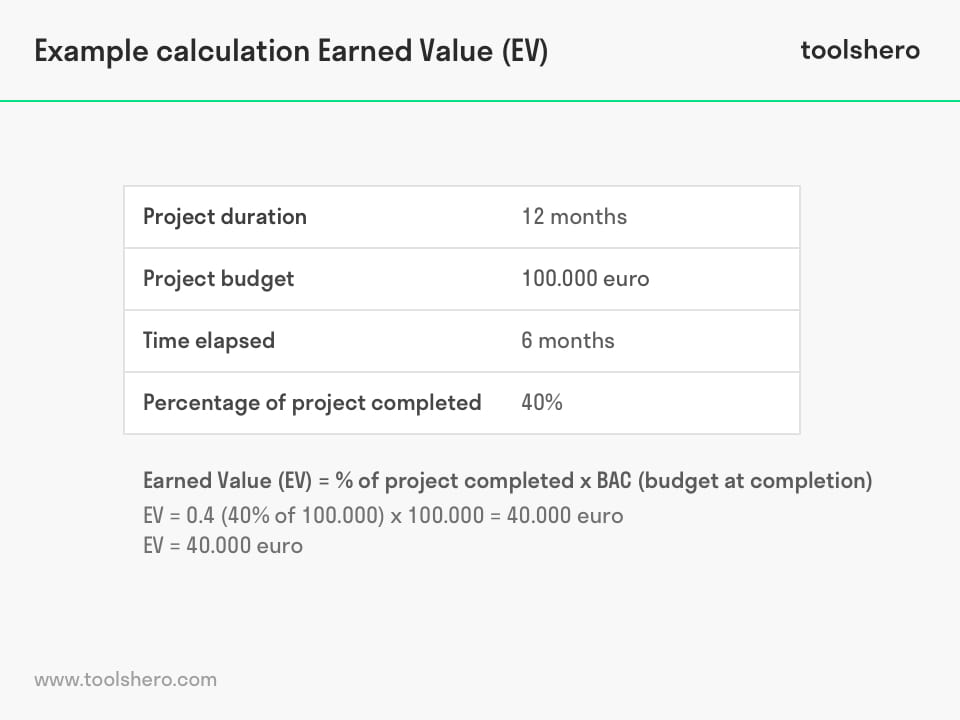Earned Value Management (EVM)

Earned Value Management (EVM): this article provides a practical explanation of Earned Value Management (EVM). Next to what it is (definition), this article also highlights it’s origin, the goal, the terminology, a complete earned Value Management example of a calculation and formulas and the five sectors. After reading, you will understand the basics of this powerful project management tool. Enjoy reading!
What is Earned Value Management (EVM)? The basics
Definition of Earned Value Management
Earned Value Management (EVM) is a project management method for objectively measuring project performance and progress. This approach to management can provide early insight into cost and time-related problems when integrating any type of programme.
In other words, EVM can be used to assess work progress based on data on time and cost performance. It also provides managers with a summary for effective decision making.
Where did Earned Value Management originate?
The concept of EVM became essential to project management in 1966. EVM was developed within the United States Air Force to plan and audit Air Force programmes. In the decades that followed, the concept remained largely unchanged.
Importance of Eearned Value Management
According to NASA, the first version of EVM was developed by the Department of Defense.
Since 2005, EVM has been part of US federal project risk management disciplines. EVM is also used by various companies, consultancies, and educational institutions in the private sector. Below are several examples of well-known organisations that implement EVM:
- Project Management Institute (PMI)
- NASA
- Society of Cost Estimating and Analysis
- Federal Acquisition Institute
What is the goal of EVM?
The basic concept of EVM is more than just an effective way to perform planning and cost inspections. Earned Value Management (EVM) is an umbrella term that defines a set of requirements or guidelines (32 to be precise) that a management system must comply with.
The objectives of EVM are:
- Uncovering the relationship between planning, technical performance, and cost performance.
- Allocating budgets to contract tasks or work overviews
- Providing a basis for recording progress against the basic plan
- Accurate and verifiable data management as the basis for analyses
- Providing a practical summary for effective decision making
Terminology in Earned Value Management (EVM)
Both the contractor and client enjoy significant benefits from a well-defined EVM system. For example, benefits for contractors include better visibility and control to respond quickly and proactively to challenges or problems.
It also becomes easier to comply with the project schedule, costs, analyses, and technical objectives. Benefits for the client, on the other hand, include a degree of confidence in the contractor’s ability to manage, execute, troubleshoot, and deliver the project.
Earned Value Management (EVM) has introduced various new terminology. Below is a summary of the most important ones.
The article will subsequently take a closer look at the different sections or elements of EVM, and its practical value for organisations and managers.
Budgeted Cost for Work Scheduled (BCWS)
This is also referred to as the planned value, and includes all costs that remain to be incurred before the project or programme is completed.
Budget At Completion (BAC)
This refers to the sum of all budget values previously determined for the work to be performed on a project, or on components of a project.
Estimate At Completion (EAC)
This term consists of the cumulative actual cost of past work plus the estimate of future costs incurred before the project is completed.
Schedule Variance (SV)
This is also calculated as BCWP-BCWS. If the result is greater than 0, this means a favourable status quo compared to the schedule. A result less than 0 means that the project is behind schedule.
Cost Variance (CV)
The cost deviation is calculated as BCWP-ACWP. A result greater than 0 is favourable and means no extra costs. A result less than 0 is unfavourable and means that the costs are exceeded.
Actual Cost of Work Performed (ACWP)
This consists of the actual cumulative costs of past work performed within the project or programme.
Budgeted Cost for Work Performed (BCWP)
This represents the amount budgeted for certain work within a project or programme.
Earned Value Management example formulas and calculation Planned Value (PV)
The formula for calculating the Planned Value is simple. The formula and an example of the correct calcuation is shown below.
Planned Value (PV) = (Planned % Complete) x (BAC)
Example Planned Value
Any project must be completed within twelve months. The budget is € 100,000. At this point, six months have already passed, and the planning indicates that 50% of the work must be completed. What is the value of the project in Planned Value (PV)?
| Project duration | 12 months |
| Project budget | 100.000 euro |
| Time elapsed | 6 months |
| Percentage of project completed | 50% |
Planned Value (PV) is as follows:
PV = (50/100) x 100.000
PV = 50.000 euro

Figure 1 – Example of Planned Value Calculation
Earned Value Management example calculation Earned Value (EV)
The EV formula is not complicated either:
Earned Value (EV) = % of project completed x BAC (Budget At Completion)
Scenario example EV
This example is a project that must be completed within 12 months. The budget for the project is € 100,000 . At this point, six months have already passed, and € 60,000 has been spent. Only 40% of the project is planned to be completed. What is the current EV of the project?
| Project duration | 12 months |
| Project budget | 100.000 euro |
| Time elapsed | 6 months |
| Percentage of project completed | 40% |
Earned Value (EV) is as follows:
EV = 0.4 (40% of 100.000) x 100.000 = 40.000 euro
EV = 40.000 euro

Figure 2 – Example Earned Value Calculation
Earned Value Management: 5 sections of Earned Value Management (EVM)
As mentioned earlier, Earned Value Management (EVM) consists of 32 guidelines. These guidelines are divided into five sections. These are explained below.
1. Organisation
The first part, organisation, contains five guidelines aimed at organising all work within a project or programme. One of the most fundamental parts of this is creating a work-breakdown structure (WBS) by the contractor.
This should be a comprehensive WBS, describing all tasks to be performed at all levels. It should also clearly state how these tasks are related to achieving the objectives. A division of roles is also essential for the first part of the EVM techniques.
Although this can be included in the WBS, it is advisable to calculate a separate organisational structure with a division of roles and different responsibilities.
2. Planning and budgeting
The second EVM section includes 10 guidelines containing basic requirements for planning and budgeting. The project has an integrated main schedule.
This acts as the project roadmap for achieving the objectives. This schedule should also include the resource allocation such as the budget for the work to be performed as planned.
This schedule is the basis for the monthly budget or BCWS. This applies to every task in the project. The total budget for all tasks together is called the Budget At Completion (BAC). Because many projects are started with a degree of uncertainty and risk, many project managers usually reserve part of the value as a Management Reserve (MR).
MR plus BAC is equal to the total project value, and is expressed as the Contract Budget Base (CBB).
3. Accounting Considerations
The third EVM section is a simple yet lengthy project management set consisting of six guidelines.
These are included to record the Actual Costs of Work Performed (ACWP) that have been spent for all project efforts together. The actual costs must be recorded in a manner consistent with the way work is planned and budgeted.
This third section demonstrates the need to select the correct time to plan key project assets and materials and to accurately collect project performance data. This part is also used to build costs for different materials in the same month that the BCWP was included. This is done to avoid misleading cost deviations. This is referred to as booking delay.
4. EVMS analysis and EVMS Management Reports
The fourth and penultimate section of EVM consists of six guidelines and is very important. This is because human attention and interpretations sometimes cause cost and planning differences, make new estimates, and determine an estimate for the full EAC.
In particular, this section covers audit techniques for assessing past and future performance. It also includes calculations to determine the approved EAC and estimated completion date.
5. Revision and data maintenance
The final section consists of a set of five guidelines that emphasise the disciplined and timely integration of customer-centric change. This also includes stop work orders (SWO). The guidelines apply to internal planning and project analysis. A lack of control can sabotage a project.
The drawing up and updating of plans and budgets is essential in order to be able to retrospectively assess the work done for each period. Revision and data maintenance in program management is a must for proactive and meaningful Earned Value Management systems (EVMS).
Pitfalls of Earned Value Management (EVM)
When performing Earned Value Management (EVM), always consider the following.
Do not solely rely on EVM.
Make sure you don’t rely on EVM values alone. EVM only represents an objective data point.
The total Earned Value (EV) in a project can quickly change, and actual costs and project planning are rarely equal to what was planned.
The Earned Value (EV) serves as a suitable early identification system for trends and alerts. The EV is usually reported on a monthly basis, but this can also be done on a weekly basis in case of smaller projects.
Customer satisfaction
Customer satisfaction and project quality are not included in EV calculations. This is why this point is an extension of the first pitfall. While EV is useful for measuring project performance against schedule and budget, it does not guarantee project success. This is because there are too many interests attached to a project.
You should therefore implement EVM in combination with traditional project management techniques.
Accurate cost accounting
It is very important to ensure that only actual costs are included in the calculations. Make sure these numbers are accurate. If the data is incomplete or incorrect, this will affect all subsequent calculations. Make sure the data is presented in a clear manner, and that you understand the calculations and values.
Benefits for customers and contractors
An EVM system is an extremely useful tool for both the contractor and client. The benefits of implementing EVMS are summarised below:
- Early warning and analysis techniques for EV problems
- Integrates performance across planning, costs, and technical performance
- Identifies problem areas that require immediate attention
- Enables accurate reporting of costs and planned consequences of decisions taken
- Provides a clear overview with different responsibilities for certain activities
- Encourages a clear definition of a project’s expectations
- Improves the planning process
- Provides consistency and clear communication about the progress of a project or programme at all management levels.
- Improves visibility, transparency, and accountability of the project or programme
Now it’s your turn
What do you think? Are you familiar with the explanation of Earned Value Management (EVM)? Have you ever executed a project or programme using Earned Value Mangagement (EVM)? What do you believe are the benefits of such a management approach? Do you have any other tips or additional comments?
Share your experience and knowledge in the comments box below.
More information
- Christensen, D. S. (1998). The costs and benefits of the earned value management process. Journal of Parametrics, 18(2), 1-16.
- Kim, E., Wells Jr, W. G., & Duffey, M. R. (2003). A model for effective implementation of earned value management methodology. International Journal of Project Management, 21(5), 375-382.
- Lipke, W., Zwikael, O., Henderson, K., & Anbari, F. (2009). Prediction of project outcome: The application of statistical methods to earned value management and earned schedule performance indexes. International journal of project management, 27(4), 400-407.
- Naeni, L. M., Shadrokh, S., & Salehipour, A. (2011). A fuzzy approach for the earned value management. International Journal of Project Management, 29(6), 764-772.
How to cite this article:
Janse, B. (2020). Earned Value Management (EVM). Retrieved [insert date] from Toolshero: https://www.toolshero.com/project-management/earned-value-management/
Published on: 12/29/2020 | Last update: 03/14/2023
Add a link to this page on your website:
<a href=”https://www.toolshero.com/project-management/earned-value-management/”>Toolshero: Earned Value Management (EVM)</a>












